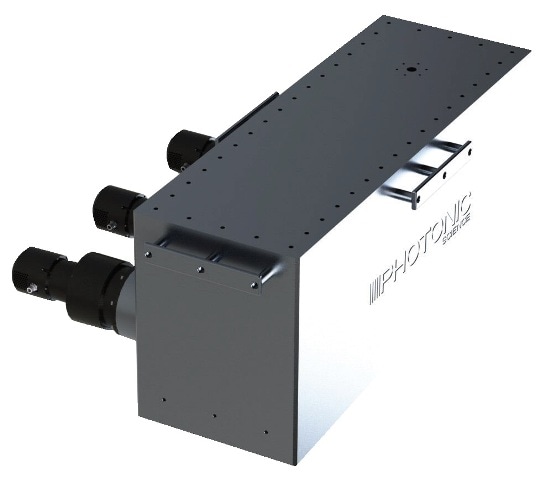The neutron imaging detector system available from Photonic Science helps in recording a unique digital backscattered neutron Laue diffraction pattern. This is achieved by a center hole included in the system. The center hole permits the neutron beam to penetrate through the camera system before reaching the sample.
This set up enables the neutron scintillator to be located very close to the sample, allowing a large solid angle of diffracted beams to be imaged.
High-resolution/high-sensitivity is realized because of the use of a custom scintillator as well as an intensified cooled CCD camera readout allowing high electro-optical gain down to single neutron sensitivity.
Prolonged exposures can be used for exposing weak diffracting patterns.
By feeding a TTL triggering pulse to a BNC connector, synchronization with pulsed neutron sources reaching 100 ns at a repetition rate of 50 Hz can be achieved. A device server driver allows remote, real-time acquisition.
The Neutron imaging detector system utilizes a Lithium-6 screen manufactured by Photonic Science’s sister company, Scintacor.
The range of cooled neutron detectors offered by Photonic Science uses LiF:ZnS:Ag scintillator screens that are read out by very low-noise, high-sensitivity sCMOS or ICCD sensors.
Imaging applications use 10 cm x 10 cm up to 43 cm x 43 cm active-area high-resolution scintillators integrated with a low noise, fast read-out sCMOS camera of a resolution of 4096 x 4096.
Diffraction and Small-Angle Scattering applications use 26 cm x 20 cm active-area, high-efficiency scintillators integrated with an ultra-low noise ICCD camera of a resolution of 1306 x 1040. This enables a single quantum detection capability.
Larger detection areas can be acquired by tiling many cameras together. A version for faster neutrons is available for research reactor facilities as well as laboratory sealed sources.
Key Features
- Multiplexed acquisition from tiled arrays
- Genicam compliance
- Acquisition of 16-bit digitized image in real time
- Very high dynamic range of up to 20,000:1
- Readout noise is equivalent to a single neutron
Applications
- Protein crystallography
- Neutron tomography/radiography
- Small-angle neutron scattering
- Neutron diffraction
- Neutron reflectometry

Image Credit: Photonic Science
Specifications for PSEL ICCD and sCMOS Neutron Detectors
Table 1. Source: Photonic Science
| CHARACTERISTICS |
Neutron ICCD |
Neutron sCMOS |
| Scintillator |
LiF:ZnS:Ag |
| Pixel size |
201 μm |
105 μm |
| Input size |
20 cm x 26 cm |
43 cm x 43 cm |
| Frame rate |
0.6 fps |
5 fps |
| Dynamic range |
>10,000:1 |
>20,000:1 |
| Read-out noise |
<3e |
4e |
| Internal gain |
>1000:1 |
N/A |
| Gating time |
<1 ms @ 1KHz |
N/A |
| Sensor operating temperature |
-20 °C |
| Exposure time (single frame) |
up to 30 minutes |
up to 1 minute |
| Camera interface |
Gigabit Ethernet |
Lithium-6 Based Screens from Photonic Science’s Sister Company Scintacor
Table 2. Source: Photonic Science
| CHARACTERISTICS |
Physical Properties |
| Screen type |
ND |
| Phosphor type |
Particulate blend |
| Emission colour |
Blue |
| Peak emmission |
450 nm |
| Decay to 10% |
3.5 μs |
| Afterglow |
Low level |
| X-ray absorption |
Very low |
| UV absorption |
Broad band |